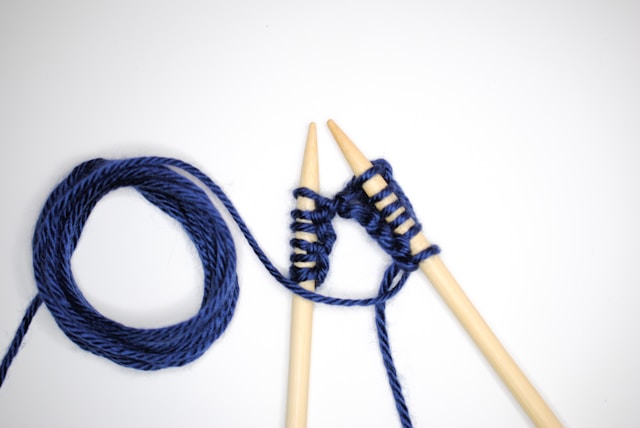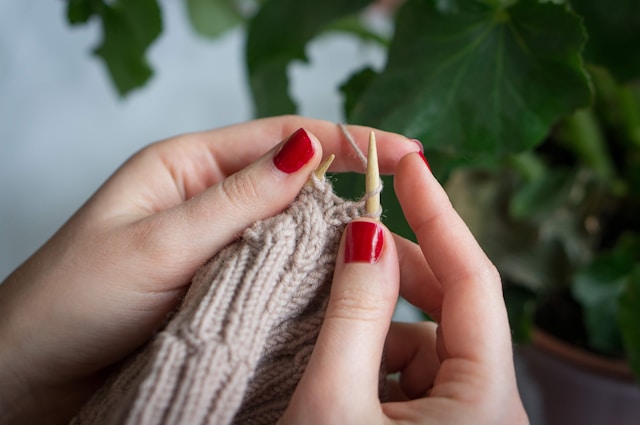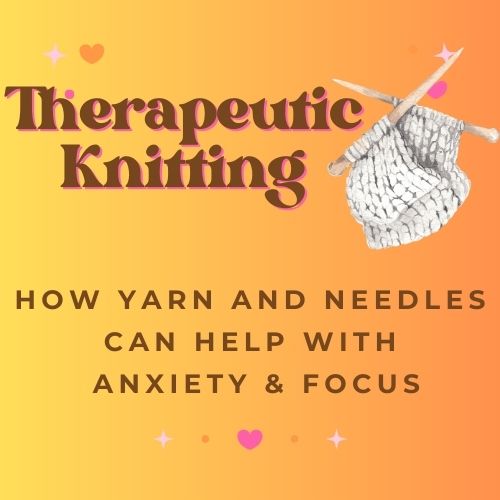There is something about the steady rhythm of knitting that makes the world feel a little quieter. The gentle looping of yarn over needles, the repetitive motion of stitch after stitch—it creates a kind of moving meditation, a space where the mind can settle, where breath slows, where the present moment is all that matters.
Knitting has been my refuge in stressful times, a way to quiet anxious thoughts and regain focus when my mind feels scattered. And I’m not alone in this. Knitters around the world describe their craft as a form of therapy, a calming ritual, a way to find peace in the chaos of everyday life.
But knitting isn’t just intuitively calming—science is now backing up what so many of us have long known. Research has shown that knitting for stress reduction is real, with measurable effects on anxiety, depression, PTSD, and ADHD. If you’ve ever picked up your needles and felt your tension ease, there’s a reason for that. Let’s explore why knitting is so powerful for mental health—and how you can use it as a tool for mindfulness, stress relief, and focus.
Explore this in more depth by joining my Craft to Heal workshop.

How Knitting Affects the Brain: The Neuroscience of Fiber Arts and Mental Health
Knitting isn’t just a creative hobby—it’s a powerful neurological tool. The way it engages the brain, nervous system, and motor skills makes it uniquely suited for mental health benefits. Here’s why:
1. Knitting Activates the Relaxation Response
- Knitting engages the parasympathetic nervous system, which is responsible for calming the body and counteracting stress.
- The repetitive, rhythmic motion of knitting has been shown to have effects similar to meditation or deep breathing exercises, helping to lower heart rate, blood pressure, and cortisol levels (the stress hormone).
- This helps explain why so many people turn to knitting when they feel overwhelmed—it provides a natural, built-in stress reliever.
2. Knitting Increases Dopamine & Enhances Mood
- When we engage in pleasurable activities like knitting, our brains release dopamine, a neurotransmitter associated with pleasure, motivation, and reward.
- This boost in dopamine helps combat feelings of anxiety and depression, giving knitters a sense of satisfaction, calm, and even joy.
- Unlike passive activities like scrolling on a phone, knitting actively engages the brain in a way that improves mental well-being.
3. Knitting Improves Focus & Cognitive Function
- Studies suggest that knitting can help improve attention and concentration, making it a valuable practice for people with ADHD or difficulty focusing.
- The act of following a pattern, counting stitches, and maintaining tension requires just enough cognitive effort to keep the brain engaged without overwhelming it.
- This makes knitting an excellent activity for mindful engagement—keeping the hands and brain busy in a way that supports mental clarity.
4. Knitting Helps With Trauma & PTSD Recovery
- For people with PTSD, repetitive activities like knitting can be grounding, helping to regulate emotions and provide a sense of safety.
- Knitting can act as a form of self-soothing, helping the brain and body return to a state of balance after heightened stress or anxiety.
- Many trauma survivors use knitting as a nonverbal coping strategy, allowing them to process emotions without having to put them into words.
5. Knitting Engages Both Hemispheres of the Brain
- Unlike many activities that only activate one part of the brain, knitting engages multiple brain regions at once:
✔ The left brain (logical) is active when following a pattern and counting stitches.
✔ The right brain (creative) is engaged when selecting colors, textures, and designing projects.
✔ The motor system is involved in the precise hand movements, enhancing fine motor skills. - This full-brain engagement makes knitting mentally stimulating while still being deeply relaxing.

Why Mindful Knitting Is So Effective for Stress Relief
Many people knit passively—while watching TV, listening to a podcast, or filling time. But when you bring mindfulness to your knitting practice, it becomes an even more powerful tool for stress reduction, relaxation, and focus.
Here’s how mindful knitting works:
✔ You focus on the sensations—the texture of the yarn, the click of the needles, the rhythm of the stitches.
✔ You slow down and breathe with your movements—matching your breath to the pace of your knitting.
✔ You let go of judgment or perfectionism—accepting each stitch as it comes.
✔ You use knitting as an anchor for presence, gently bringing your mind back when it wanders.
This simple shift—from passive knitting to mindful knitting—can transform your craft into a meditation.
Explore This Deeper in Craft to Heal
If you want to use knitting as a tool for mindfulness, emotional well-being, and stress relief, Craft to Heal is a space to explore that deeper.
This year-long workshop series focuses on:
✔ Knitting and fiber arts as mindfulness practices.
✔ Using creativity as a tool for stress relief and focus.
✔ Building a meditative crafting habit.
✔ Finding joy in the process, rather than focusing on the outcome.
🧶 Want to learn more? Click here to join Craft to Heal.
Knitting Your Way to Calm
Knitting is more than a craft—it’s a way to find peace in the present moment.
Each stitch is an opportunity to slow down, to breathe, to be here now.
Each row is a reminder that progress happens one step at a time.
Each project is a reflection of the calm, care, and creativity you bring into the world.
So the next time you pick up your needles, try knitting not just for the end result—but for the experience itself.
Because sometimes, the most healing thing we can do is simply keep knitting.

